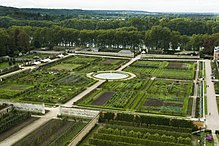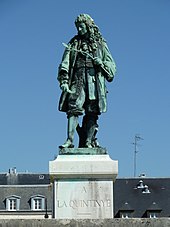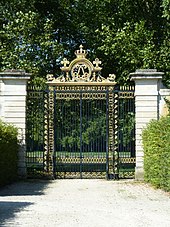Potager du roi
The Potager du roi (German: kitchen garden of the king ) is a kitchen garden at the Palace of Versailles that was laid out between 1678 and 1683 by Jean-Baptiste de La Quintinie on behalf of the Sun King Louis XIV . The kitchen garden supplied the Versailles court with fruit and vegetables and was a status symbol at the king's court due to its splendid layout and valuable plant stock. The approximately 9 hectare garden, located south of the palace and has been preserved for more than 300 years, is provided by the University of Applied Sciences École nationale supérieure de paysage de Versailles operated and maintained.
As early as 1926, the Potager du roi, together with the Parc de Balbi, was declared a monument historique by the Ministry of Culture . Together with the Palace of Versailles and its park, it has been a UNESCO World Heritage Site since 1979 .
The garden at the time of Louis XIV.
The establishment of the Potager du roi was decided in 1678 by Louis XIV. After he had converted the Palace of Versailles, which had initially only been his father's small hunting lodge, into a palace and designated it as the seat of government in 1677, the previous kitchen garden, located southeast of the palace with its area of just under 4 hectares, had become too small to accommodate the to supply the royal court with fruits and vegetables. He commissioned Jean-Baptiste de La Quintinie, who had been appointed director of the orchards and vegetable gardens of the royal castles as early as 1670, with the planning and construction.
At the place designated for the Potager du roi there was a pond known as the “Stinking Weiher”. The excavated soil from the construction of the Piece d'eau des Suisses , another park pond, was used to fill this pond. In order to improve the quality of the soil, fertile soil was removed from the hills of Satory and from the Parc-aux-cerfs , which was also enriched with manure from the royal stables. Since the area was still very humid, La Quintinie had an underground aqueduct built for drainage , through which the water was directed into the Swiss basin.
The garden was supposed to provide the royal court with fresh fruits and vegetables. In addition to the sheer amount of food that the garden had to produce for this, the king also attached great importance to having fruit and vegetables for his own table and for entertaining guests outside of the actual season. Like everything in Versailles, it was also intended to serve as a representation, so that the complex, which the king regularly visited on walks, was also planned and laid out according to aesthetic aspects. For the king, who was happy to be personally guided through the complex by La Quintinie, a separate side entrance was created with a richly decorated gate with his insignia. The Grille du roi ("King's Gate") is the only gate in Versailles that has survived in its original form from the time of Louis XIV. Even stately visitors to the court, such as the Doge of Venice or the King of Siam , were personally guided through the Potager du roi by Louis XIV, for whom the garden was also a symbol of the mastery of nature and thus of his absolutist power .
The garden was bordered on three sides by about three meter high walls with a total length of 800 meters, which La Quintinie had planned and built by the court architect Jules Hardouin-Mansart . These were widened to walk-on terraces, from which the king and his entourage had a view of the entire complex. Numerous corridors and chambers were laid out beneath the terraces, which the potager's 30 gardeners used to store tools, store water cisterns and also store the harvest. 29 chambers with walls facing south, east and west were set up on the outer wall. Inside these chambers, the air could warm up quickly, even in winter. The walls also offered protection from cold winds and served as heat storage. Sensitive plants like melons, figs, cucumbers, peaches and nectarines as well as strawberries and early cherries were cultivated here. In the center of the garden, the “Jardin des gros légumes” (“Garden of Big Vegetables”) consisting of 16 beds, with a water basin in the center, was created.
In order to meet the farm's demands for fruit and vegetables out of season, La Quintinie worked with various cultivation methods. There were no greenhouses made of glass during his lifetime, the idea only came to France from the Netherlands half a century later. In addition to the drift walls, he also used glass bells , which on the one hand served for early forcing, but on the other hand also for decoration and the display of special plants. By growing several different varieties of each type of fruit and vegetable with different ripening dates, La Quintinie was also able to prolong the respective harvest season. He also used horse manure to warm the earth early and covered individual beds with glass.
In this way he managed to supply the Versailles court with strawberries in January and with peas in April. The first figs, of which the Potager du roi had to deliver 4,000 pieces per day to the farm during the main ripening period, were harvested in June, the first asparagus in December. Particular attention was also paid to fruit growing on espaliers. On the one hand, this cultivation method served to produce fruits of particularly high quality. The trees were cut in such a way that the fruits were well lit by the sun; The trees also produced larger fruits on the small roots . On the other hand, the trees, often cut into artistic shapes, were also an ornament and decoration for the garden.
The importance that Louis XIV ascribed to the delivery of his table with fruit and vegetables can be read from a traditional ironic remark by the Marquise de Sévigné :
«Le chapitre des pois dure toujours; l'impatience d'en manger, le plaisir d'en avoir mangé, et la joie d'en manger encore sont les trois points que nos princes traitent depuis quatre jours. »
“The pea chapter continues; the impatience to eat them, the pleasure of having eaten them and the joy of eating them again - these are the topics that have been discussed for four days. "
Until his death in 1688, La Quintinie, to whom Louis XIV bestowed a title of nobility in 1687 for his services in horticulture, worked on improving the cultivation and forcing methods. He published the knowledge gained in a standard work on horticulture Instruction pour les jardins fruitiers et potagers , which, however, did not appear posthumously until 1690.
From La Quintinie's death to modern times
In the years after La Quintinie's death, the cultivation of early vegetables was initially expanded considerably and the kitchen garden was expanded to include an additional area for growing asparagus. This part of the garden is known as the Duhamel du Monceau garden. After a few years the walls were shortened to give the plants more air and light. In 1715, under the leadership of Louis Le Normand , the cultivation of coffee plants began. He was the first to have glass greenhouses built in the garden, with the help of which he became King Louis XV in 1735 . was able to present for the first time pineapple fruits that had been harvested in the Potager du roi.
From around the middle of the 18th century, the potager du roi became increasingly less important. In 1767 there were plans to build a nunnery for the queen on part of the area. In order to be able to continue the Rue d'Anjou, in 1769 the plan arose to break through the outer wall with a gate, which in the summer of 1785 under the English gardener Alexander Brown, who in 1782 was appointed “Inspector of the Orchards and Vegetable Gardens of the Royal Palaces” had been implemented. Brown also redesigned the garden significantly by having ramps built that gave direct access to the central bed. He also had some of the drift walls torn down and new warm houses built.
In 1793, the gardener at the time, a gardener named Goudouin, had to resign from his position due to the French Revolution after the garden had been used for target practice in previous years and parts of the area had been parceled out and rented out to private individuals. In 1798, by government decree, the Potager du roi was designated as an experimental garden with an attached school, which was closed again with the introduction of the German Empire .
In 1849 Auguste-Francois Hardy was appointed head gardener of the royal kitchen garden, who succeeded in returning the garden to its original use as a kitchen garden for the royal court. During the Prussian occupation of Versailles in 1870/71 he had to supply the Prussian instead of the French court with the products. During the Third Republic in 1874, the garden was incorporated into the new Ministry of Agriculture and Commerce, which opened a horticultural school there in May of that year, under the direction of Hardy.
In 1918 the school was named "École nationale d'horticulture", at which the course "Rural Areas and Horticulture" was finally introduced in 1945 to train landscape architects, and from which in 1976 the Versailles School of Horticulture and Landscaping (École nationale supérieure de paysage de Versailles, ENSP).
The garden in the 21st century
The Potager du roi is considered the largest kitchen garden in the world. It is affiliated with the University of Horticulture and Landscaping and is maintained by students.
Since the gardener Antoine Jacobsohn took over the management of the Potager du roi in 2007, it has been managed exclusively according to ecological guidelines. Although the gardeners largely adhere to old plans for maintaining the garden as a historical cultural monument, concessions are made to ecological management. Clover, which serves as natural green manure, grows under the trellis trees and on some paths. Around 400 different types of fruit are grown in the garden, including 160 different types of apples on 2000 trees and 140 types of pears on 2800 trees, and about as many different types of vegetables. The annual harvest is around 30 tons of fruit and 20 tons of vegetables, some of which are directly marketed in an attached shop. The garden was and is also known for its particularly ornate fruit trellises. There are 68 different ways of forming trellises. The oldest preserved trees in the garden were planted around 1800.
As part of the park of the Palace of Versailles, the Potager du roi, together with the palace, has been a UNESCO World Heritage Site since 1979.
literature
- Vincent Brunot: Le Potager du roi. Gallimard, 2005.
- Pierre David, Gilles Mermet and Martine Willemin: Le Potager du roi. La Martinière, 2010.
Web links
- Literature by and about Potager du roi in the WorldCat bibliographic database
- Official website
Individual evidence
- ↑ Entry of the Potager du roi in the list of Monuments historiques , accessed on 23 September 2018.
- ↑ a b Palace and Park of Versailles on the UNESCO World Heritage Site, accessed on September 27, 2018.
- ↑ a b c d Catharine Reynolds: Where Versailles Grew Its Veggies. New York Times, September 11, 1994, accessed September 25, 2018.
- ↑ a b c d e f g Pierre David, Gilles Mermet, Martine Willemin: The king's kitchen garden. Dumont-Verlag 2011, ISBN 3-8321-9389-8 , p. 9 ff.
- ↑ a b c Katja Mutschelknaus: The ballet of the trees. In: Die Welt (online) of October 22, 2011, accessed on September 27, 2018.
- ↑ Vitamins for the Sun King. In: Neue Zürcher Zeitung, August 4, 2009, accessed on September 29, 2018.
- ↑ a b Christa Hasselhorst: A royal land of milk and honey. In: FAZ online, August 27, 2018, accessed on September 24, 2018.
- ↑ Pauline frileux: An agroecological revolution at the Potager du Roi (Versailles). In: The Urban Garden City - Shaping the City with Gardens Through History. Springer-Verlag, 2018, ISBN 978-3-319-72732-5 , pp. 101-130, doi: 10.1007 / 978-3-319-72733-2 6 .
Coordinates: 48 ° 47 ′ 55 ″ N , 2 ° 7 ′ 16 ″ E





